Even as we near the end of summer, it’s likely that your grass is still growing faster than you can keep up with, which means you have to cut it constantly — for some, including yours truly, that’s like every week. That is tough, but even worse, maybe as you’re pulling out your mower from last year, you’re finding out that it isn’t starting with the same gusto that it once did or cutting as effectively. That means you’re due for an update, which could cost you a pretty penny. We’ve found the best lawn mower deals for you this year, which include a surprising amount of electric lawn mowers on the cheap, but you’ll find some gas and robotic lawn mowers featured as well. It’s all part of getting ready for summer! Now, quickly, go find a decent mower so you can quit cutting grass and starting getting back to your favorite summer movies.
Contents
- Greenworks 25112 — $138, was $188
- American Lawn Mower Company 50514 — $149, was $160
- Litheli 20-volt Cordless — $176, was $296
- Yard Machines 125cc gas — $227, was $279
- PowerSmart 144cc 2-in-1 gas — $240, was $300
- HART 40-Volt Cordless — $294, was $328
- Greenworks 40V — $374, was $449
- Husqvarna 18-volt Automower 430X — $2,000, was $2,500
- EcoFlow Blade robotic mower — $2,199, was $2,699
- How to choose a cheap lawn mower
Greenworks 25112 — $138, was $188
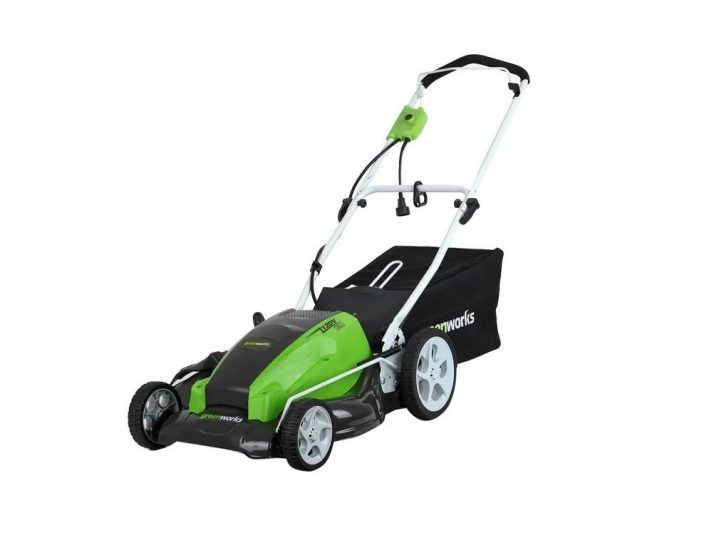
Greenworks has a mower with a bit of heft to it to add to the lineup this year. As it has a 3-foot deck width, you can say it cuts a full yard in each pass over of your yard. Much like the previous model, it is corded (the cordless are coming next!), but this wider cutting width will make it more appropriate for larger yards. If you have an appropriately long extension cord, the 14 amp motor can take care of the rest, with typical customers marveling at its strength despite what they may have thought about average electric mowers. Just push the power button and off you go! The Greenworks 25112 is full of options, as well, with an optional bag and mulching modes as well as seven cutting heights to choose from. When you’re done mowing, you can fold the handle down to make the Greenworks 25112 more compact and save space in your garage.
American Lawn Mower Company 50514 — $149, was $160
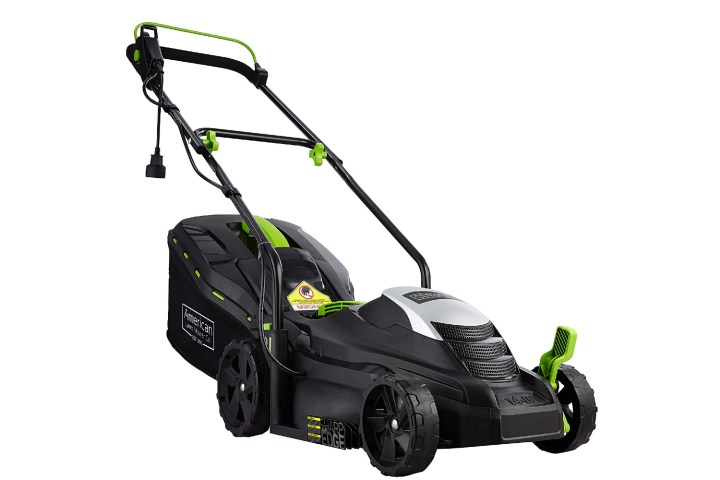
The American Lawnmower Company has created a lawn mower that works well and isn’t enormously heavy — a mere 20 pounds. With its 14-inch cutting width and absurdly low weight, you can zip through small jobs quickly and get back to whatever else it is that you’d prefer to be doing in a hurry. The only odd point, at least if you’re coming from traditional lawn mowers, about the American Lawnmower Company 50514 is how it is a corded mower. This means you’ll have to slightly adjust your mowing to be more like vacuuming with a corded vacuum. It also means that, even with an extension cord, you won’t be able to stray too far from home with it. As a result of its weight and corded nature, the American Lawnmower Company 50514 is perfect for smaller homes (and people).
Litheli 20-volt Cordless — $176, was $296

Thanks to its brushless motor, capable of 4500 RPMs, you’ll get significantly reduced vibration and noise when mowing, even the toughest of lawns. Pairing that with the five separate cutting heights, and a 13-inch blade, you’ll see effective cuts on your blades of grass with near effortless labor behind it — you don’t have to work as hard to get an even and in-depth cut. The high-performance battery offers 25 minutes of runtime on a single charge with a lock-off button and trigger switch for safety. It’s a great option for small to medium-sized yards. Even if your yard is bigger, you can grab an extra battery or two to extend the runtime.
Yard Machines 125cc gas — $227, was $279

Gas-powered and ready to slice and dice, this push mower has a 21-inch deck with side discharge and mulching capabilities, as well. You can easily swap between the six different cutting heights, with 8-inch rear wheels that are rugged and will glide over even tough terrain. This mower is ideal for small to medium-sized yards with light obstacles.
PowerSmart 144cc 2-in-1 gas — $240, was $300
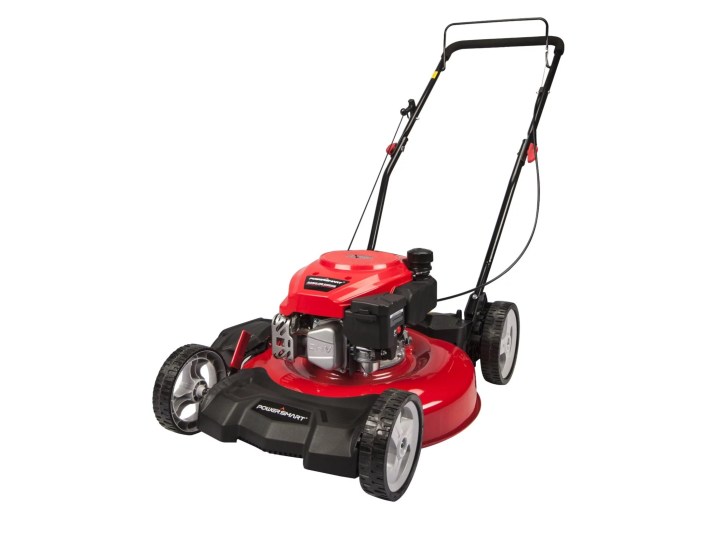
This gas-powered mower has a 144cc OHV 4-stroke engine, which offers some excellent power to drive the 21-inch all-steel deck and specialized blade. It offers five height positions to allow you to cut as low, or as high as you need. Plus, the two-in-one capabilities means it can also mulch and side-discharge if you’re in grassier or thick areas. It does come with a three-year limited warranty, which is almost unheard of for mowers.
HART 40-Volt Cordless — $294, was $328
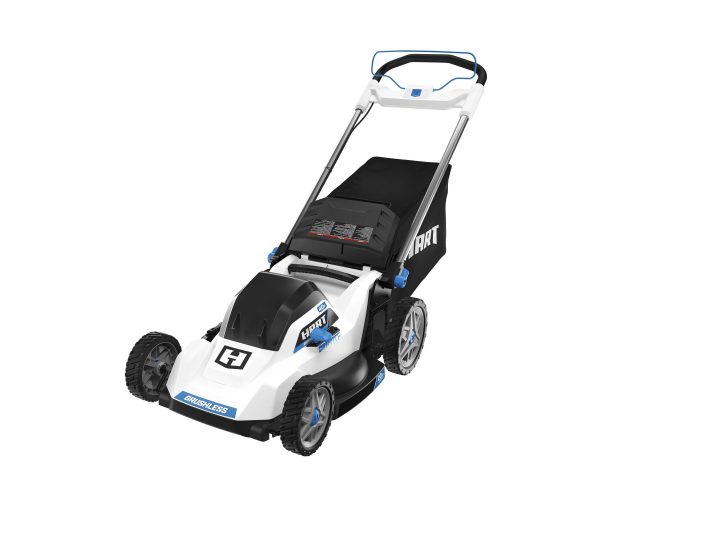
HART brings us a great sale on a cordless electric mower with staying power and unique storage options. It also happens to be the best mower if you’re in on the HART electric power tools train, because the included battery will work with your other HART products (and theirs with this). Here’s how it works: With just one charge the 20-inch mowing width of the HART can get approximately half an acre mowed, plenty for most people. If you do need more mowing time, and have another 40V battery from another HART product, you can just pull it out from the included battery storage area and swap right in the middle of the yard. Even if you don’t have another HART battery, you can still go back to the garage and use the included quick-charge base. Speaking of the garage, the HART has a very unique storage solution. Instead of laying flat and compacting the handle down to save horizontal space, the HART stands up on its handles to save floor space. If a half acre of wireless electric mowing and the rare upright storage options are right for you, try this mower this summer.
Greenworks 40V — $374, was $449
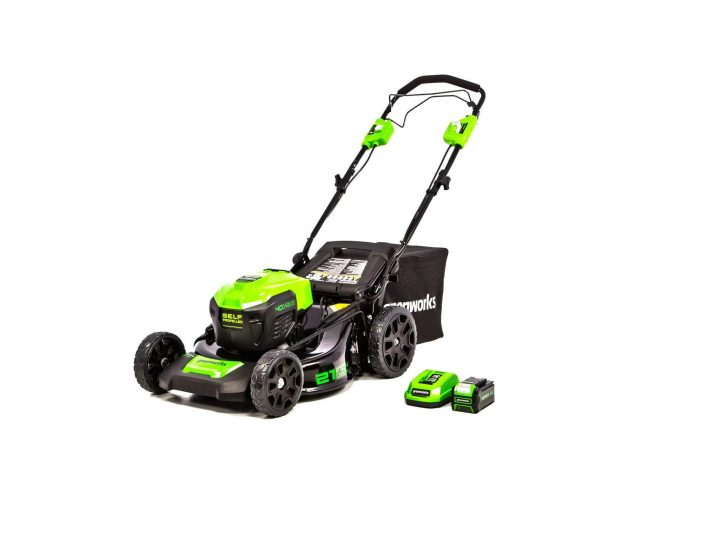
Another option for those that like Greenworks and have multiple Greenworks electric products is the Greenworks 40V 21-inch wireless lawn mower. In many ways it is similar to the mower above, as it is suitable for a half-acre lawn, has additional battery storage, an optional bagger and mulch modes, and a battery that works with many other products in the company’s electric lineup. In fact, it even has the rare vertical storage optionality. So, where do the two differ and how can you pick which is best for you? Well, aside from the obvious choice of going for the one that shares a battery with other products you already own, the Greenworks has a couple of advantages over the HART, above. Firstly, it is self-propelled, which can save you a bit of a workout and, secondly, it has an extra inch of cutting width (21-inches). For smaller lawns, this extra bit of reach might not be super noticeable, but as you approach that half-acre mark each little square inch along the way will truly add up.
Husqvarna 18-volt Automower 430X — $2,000, was $2,500

This automatic and robotic mower will cover up to 0.8 acres of land all on its own. More specifically, it will cut 1,430 square feet of grass in about 1 hour — it runs for 145 minutes on a single charge. When it’s all done it uses GPS to navigate back to its charging dock to recharge for another day. You can configure cutting heights from 0.8 to 2.4-inches depending on how low or high you need, plus it employs collision sensors to avoid obstacles and people. You never have to worry about children and pets. Smart controls put you in the driver’s seat at the tap of a button with scheduling, location-tracking, mowing status, and much more. The convenient DIY-installation makes it super easy to setup and get started too.
EcoFlow Blade robotic mower — $2,199, was $2,699

Sit back and enjoy a cocktail while a machine does all the grass mowing for you. That’s precisely what the EcoFlow Blade offers, for up to 0.7 acres of land and wire-free navigation. You can set virtual boundaries which the mower will not travel beyond, allowing you to accurately set your property line even without fencing. The Blade also features smart obstacle avoidance and auto re-routing so the blade re-routes within an inch of the original plan to avoid missing cuts or getting stuck on obstacles. Several technologies offer anti-theft tracking via 4G, GPS, and e-SIM. Plus, the entire system is super easy to clean and maintain between use.
How to choose a cheap lawn mower
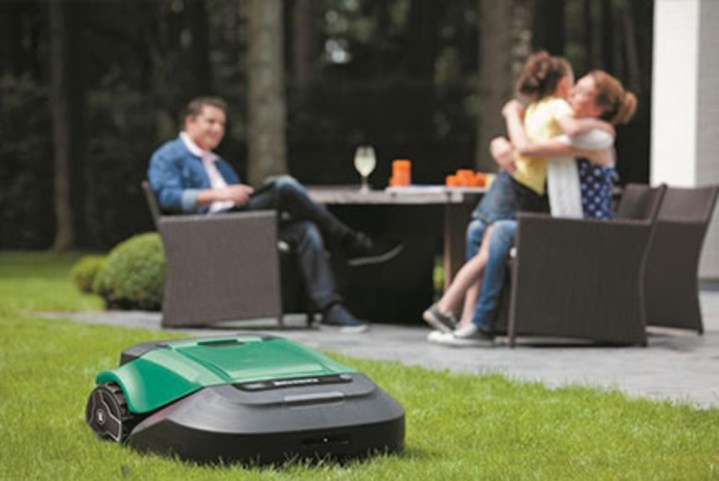
The advantages and limitations of different lawn mower types
- Gas-powered lawn mowers: Lawn mowers with gasoline motors are often the least expensive. Gas mowers are also more powerful than electric lawn mowers, which gives them an advantage if you need extra power for unusually thick and long grass or if you tend to use your lawn mower to trim weeds and other forms of plant life. You can also mow anywhere with a gas mower, as long as you have gas in the tank. The downsides of gas mowers include the necessity of keeping gasoline on hand. Gas mowers also require more maintenance than electric machines. Also, even with near-universal electric starting, gas mowers sometimes can be hard or impossible to start, which often means a trip to a repair shop. A frequent complaint about gas mowers is that they’re noisier than electric mowers.
- Corded electric lawn mowers: The least expensive electric lawn mowers require power cables long enough to reach all parts of your lawn. Handling the cables may mean it takes longer to mow your lawn as you move the cable out of the way to avoid running over it and stop to free up the cable when it gets kinked or snagged. Corded electric lawn mowers start easily and maintenance is low. Other than keeping the mower relatively clean of accumulated dried grass and mowing residue, not much is required. Because you need access to electricity to use a corded electric mower, you may lose a bit of portability as you can’t use it anywhere it cannot be plugged in.
- Cordless electric lawn mowers: Cordless electric lawn mowers cost more than electric mowers, but as long as you have charged batteries, you can mow grass anywhere you transport the mower. Cordless mowers generally have more than one power mode so you can conserve battery power on flat ground with thin or short grass and then switch to more powerful and energy-consuming modes on inclines or with thick or long grass and weeds. Most battery-powered cordless mowers today use 40-volt batteries to have enough cutting power for average lawns. Some cordless mowers use permanent batteries with built-in chargers. Models with replaceable batteries that you can charge separately from the mower let you extend your mowing time by replacing a spent battery with a fresh one. Another advantage of cordless mowers is that the manufacturers often have other tools such as edges, grass trimmers, and blowers that use the same size battery.
- Robot lawn mowers: Robot mowers are common in Europe, but still unusual in the U.S. Robotic lawn mowers run on battery power, like robot vacuum cleaners and, also like vacuums, have varying levels of self-management. For example, they need to navigate obstacles to reach all areas of the yard and monitor their power level to return to a charging station when their batteries near depletion. The greatest advantage of a robot mower is no human accompaniment or intervention is needed once the robot has been configured and scheduled. You can configure and monitor a robot mower remotely with a smartphone app and some models also respond to digital voice assistants such as Amazon Alexa. Robot lawn mowers are the most expensive type of residential mower, but their cost is expected to drop in the next few years.
The most important factors in choosing a lawn mower
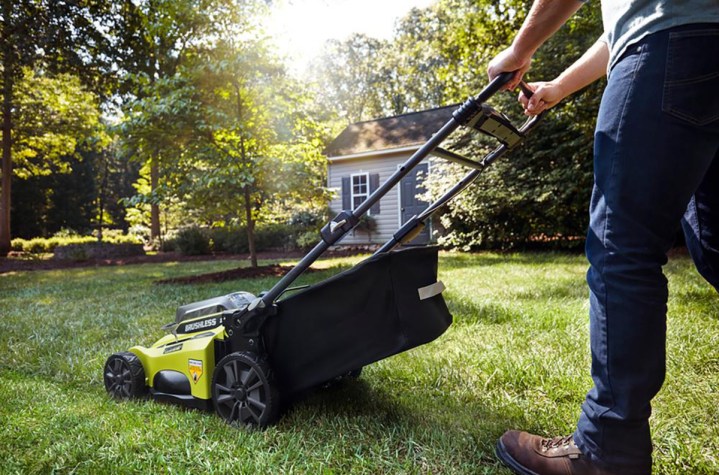
It helps to have a handle on three general factors when shopping for a new lawn mower: Yourself, your lawn, and lawn mower features. If you like to get in some cardio while mowing a half-acre lawn, your mower choice will differ from someone who has a tiny plot and want the job done with as little effort or fuss possible.
- Your lawn: Small lawns of one-tenth of an acre or less typically don’t require large, powerful lawn mowers. A small corded electric mower or a walk-behind or robot cordless mower may be sufficient. If you have a large lawn with tough-to-mow grass, steep inclines, and overly moist soil, a more powerful mower is in order. The type of grass in your lawn can matter in your mower choice as well, especially if you have grass such as Bermuda Grass that looks best when cut very short.
- Power source: See the section above for the advantages and limitations of gas, corded electric, cordless electric, and robot mowers. If you have long, narrow areas to mow, for example, a cordless electric mower might not be a good choice because you could spend an inordinate amount of time handling extra long power cables.
- Deck or cutting path width: Mowers with narrow cutting decks are lighter and easier to navigate around obstacles in tight spaces that machines with wider decks. A thinner cutting path width means you’ll need to make additional passes, and cutting your lawn will take longer. For most lawns, 19-inch to 21-inch mower deck width is a good compromise.
- Push or self-propelled: Push mowers that depend on the operator to move are lighter, cheaper, and easier to operate than self-propelled mowers. If your lawn has hills or even modest inclines, however, a self-propelled mower can relieve you of much or all of the pushing effort.
- Clipping discharge: Most walk-behind mowers have two or three of the common discharge modes: Bagging, mulching, or side discharge. If you want the neatest possible lawn, bagging is the best option, even though dealing with the bagged clippings can be tiresome and messy. Side discharge mowers are typically used with separate lawn sweepers. Mulching, which returns the grass clippings to the lawn where they can add nutrients, is the least complicated and arguably the most environmentally sound way to deal with clippings.
- Cut-grass height settings: Few lawn mowers have just one cut-grass height. Most have three or more settings. The height you choose can depend on the type of grass in your lawn or your personal preference for a neat and trim lawn or longer and softer grass. Most mowers have manual height adjustments set with one or four levers that lift the cutting blade or the mower deck. A few more expensive mowers have powered height adjustment.
Editors’ Recommendations

